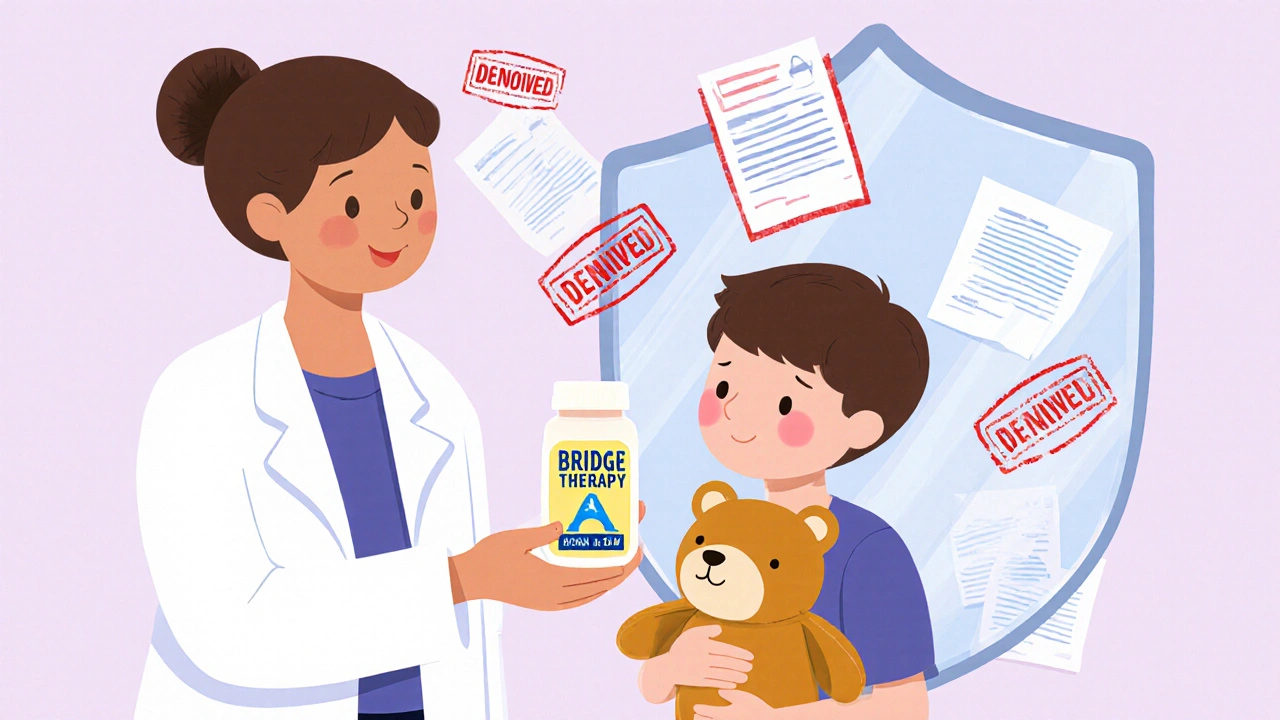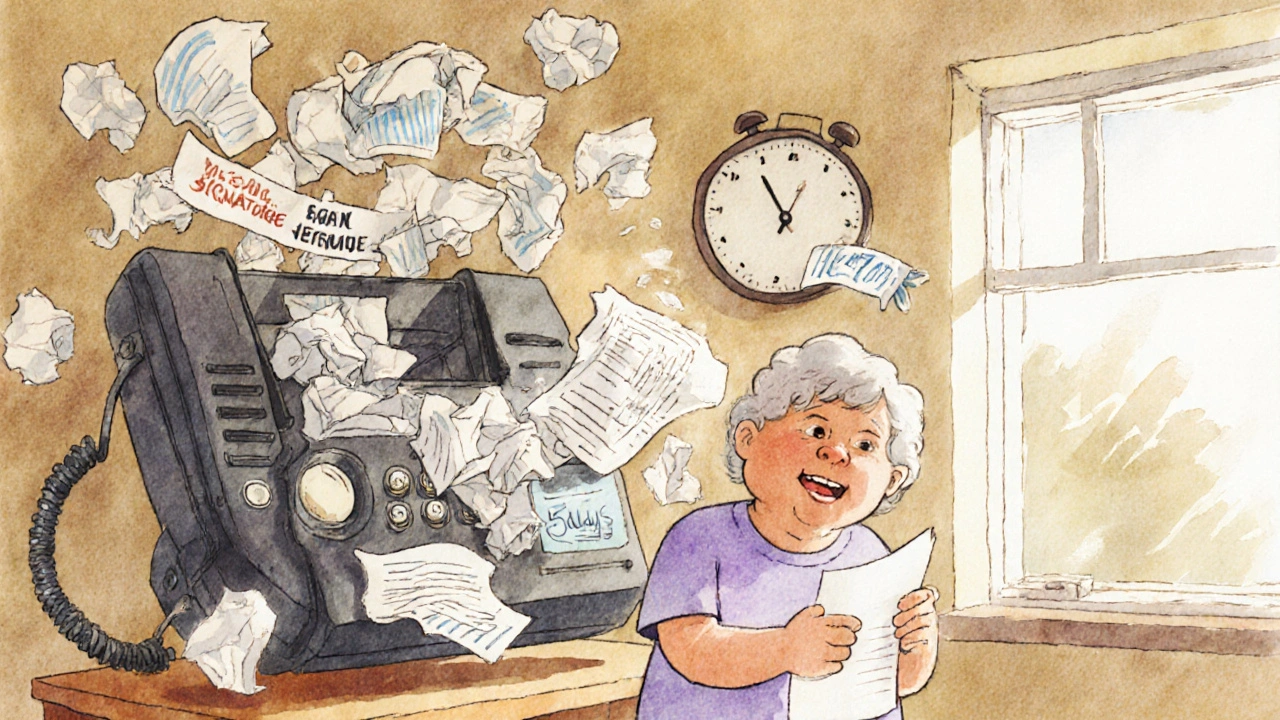Prior Authorization Risk Calculator
Input Your Situation
How This Works
Based on JAMA Oncology 2023 study: Cancer patients waiting >28 days for treatment have 17% higher risk of death. For other conditions, risk increases by 5% per week of delay.
Example: A patient with cancer waiting 35 days for treatment faces a 17% increased mortality risk.
This tool provides estimated risk based on published studies. It is not medical advice and should not replace consultation with your healthcare provider.
Risk Assessment Result
Waiting time exceeds recommended safety thresholds.
Every year, over 35 million Medicare Advantage patients face delays in getting the treatment they need-not because their doctor said it wasn’t necessary, but because a form got lost in the mail, a fax machine jammed, or an insurance reviewer missed a signature. These aren’t bureaucratic inconveniences. These are prior authorizations-and they’re creating dangerous treatment gaps that can cost lives.
What Prior Authorization Really Does
Prior authorization is supposed to be a safety check. Insurance companies use it to make sure expensive treatments-like MRIs, cancer drugs, or oxygen tanks-are truly needed before they pay for them. On paper, it sounds smart. In practice, it’s often a wall between patients and care. The system was built to stop waste, but it’s now causing more harm than good. Doctors spend an average of 16 hours a week just filling out paperwork for approvals. Staff spend another 13 hours. That’s over 30 hours a week of time that could be spent with patients. And for what? Only 15% of these requests are processed electronically. The rest? Fax machines, phone tag, and paper forms that get misplaced. Worse, the delays aren’t random. They hit the sickest patients hardest. A 2023 JAMA Oncology study found that when cancer patients wait more than 28 days for a drug because of prior authorization, their risk of death goes up by 17%. That’s not a statistic-it’s a mother skipping chemo because her insurer won’t approve the drug for another week. It’s a diabetic patient going into ketoacidosis after an 11-day delay on their insulin pump. It’s a transplant recipient missing a dose of immunosuppressants because the fax was never received.Who Gets Hit the Hardest
Not all insurance plans treat prior authorization the same. Medicare Advantage plans require it for nearly 83% of specialty drugs. Medicaid varies wildly-from 12% of prescriptions needing approval in one state to 89% in another. Commercial insurers approve only 20% of generic drugs upfront, but block 60% of specialty medications. The wait times tell the real story. Commercial insurers take about 4.7 business days. Medicaid? 7.2 days. Medicare Advantage? 5.3 days. For someone with a life-threatening condition, that’s not just slow-it’s deadly. And the denials? They’re not always based on medical need. A 2024 AMA survey found that 42% of physicians say denials are arbitrary. One doctor in Arizona told me about a patient with multiple sclerosis who was denied a new medication because the insurer claimed a cheaper version was "equally effective." The cheaper version had caused seizures in this patient two years earlier. The insurer didn’t have the medical history. The doctor had to fax it again. Three weeks later, the patient got approved. By then, she’d lost three months of mobility.How Providers Are Fighting Back
Some clinics are no longer waiting for insurance companies to fix the system. They’re fixing it themselves. One practice in Phoenix started using electronic prior authorization systems. Instead of faxing forms, they submit requests directly through their EHR. Approval time dropped from over five days to under two. Denial rates fell by 35%. They also created a checklist for every new prescription: Is this on the prior auth list? Does the patient have a history of delays? Can we start a bridge therapy? Bridge therapy means giving patients a short-term supply of medication-usually 7 to 14 days-while waiting for approval. It’s not perfect. It costs the clinic money. But it keeps patients alive. One oncology clinic reported that since they started offering bridge meds, zero patients missed a treatment cycle due to authorization delays. They also trained one staff member to be the "prior auth specialist." That person knows every insurer’s rules, which forms to use, which appeals work, and who to call when things stall. Before, everyone on the team was juggling approvals. Now, they’re focused on care.
What Patients Can Do Right Now
You don’t have to wait for the system to change. Here’s what works:- Ask your doctor at the time of prescription: "Will this need prior authorization?" If they say yes, ask for the name of the drug and the insurance code. Write it down.
- Call your insurer yourself. Don’t wait for the doctor’s office. Ask: "What’s the approval process? How long does it take? What documents do they need?" Get the name of the reviewer and the case number.
- If it’s a high-risk medication-like an immunosuppressant, cancer drug, or insulin pump-ask if the pharmacy has samples available. Many manufacturers give out free 7-day supplies.
- Use patient assistance programs. Most drug makers have them. They can cover costs while you wait.
- If you’re denied, appeal immediately. Most insurers allow 180 days, but you should act within 72 hours. Keep a log: who you spoke to, when, what they said.
The Big Shift Coming (And Why It Matters)
Change is coming-but slowly. In January 2024, CMS announced new rules: by December 2026, every Medicare Advantage and Medicaid managed care plan must have electronic prior authorization systems with real-time decisions. That means no more faxing. No more waiting 72 hours for a simple approval. The HL7 DaVinci Project’s PDEX standard is already being used by 87% of major health systems. It lets doctors check authorization status right in their EHR while writing the prescription. If the drug needs approval, the system shows you exactly what’s missing. If it’s approved, you get a green light. AI tools are stepping in too. Platforms like Kyruus and Apricus Analytics can predict which requests will be approved-and which will be denied-before you even submit them. They learn from past decisions, insurer patterns, and even the wording of clinical notes. But here’s the catch: 63% of Medicaid programs still use fax machines. And only 41% of physicians say things have improved, even with these new tools. So while the future looks better, the present is still broken.The Real Cost of Waiting
It’s easy to think, "It’s just paperwork." But the numbers don’t lie. - 82% of physicians report patients quitting treatment because of prior auth delays. - 34% have seen serious adverse events directly caused by those delays. - 18.7% of medication non-adherence is tied to prior authorization. - That adds up to $341 billion in avoidable hospital visits and complications each year. And the human cost? It’s in the stories. The Reddit post from NurseJen87. The AMA’s case file on the epilepsy patient who died waiting. The 142 documented cases at Cigna where transplant patients missed doses. This isn’t about insurance companies being greedy. It’s about a system built for cost control that forgot its purpose: keeping people alive.What Needs to Change
The fix isn’t complicated:- Eliminate prior authorization for stable, chronic conditions. If a patient has been on the same drug for two years with no issues, why require approval every time?
- Make electronic submission mandatory-no exceptions.
- Set strict time limits: 24 hours for urgent cases, 72 hours for everything else.
- Require insurers to notify patients directly, not just providers.
- Stop step therapy for life-saving drugs. Forcing someone to try a drug that failed them before isn’t cost-saving-it’s cruel.
You’re Not Powerless
You don’t need to wait for Congress or insurers to act. You can start today. If you’re a patient: ask. Document. Advocate. If you’re a provider: streamline. Train. Protect. If you’re a caregiver: know the process. Don’t assume someone else is handling it. Prior authorization doesn’t have to be a trap. It can be a tool-if we fix it. Right now, it’s a gap. And gaps in care are the most dangerous kind of risk in medicine.What is prior authorization and why does it delay my treatment?
Prior authorization is when your insurance company requires approval before covering certain medications or procedures. It’s meant to prevent unnecessary care, but because most requests are still submitted via fax or phone, approvals often take days or weeks. For time-sensitive treatments like cancer drugs or insulin pumps, those delays can be life-threatening.
Which insurance plans require prior authorization the most?
Medicare Advantage plans require prior authorization for 83% of specialty drugs. Medicaid varies by state, with approval rates ranging from 12% to 89%. Commercial insurers block 60% of specialty medications but only 20% of generics. The slowest approvals come from Medicaid, averaging 7.2 business days.
Can I get my medication while waiting for approval?
Yes. Many drug manufacturers offer 7- to 14-day free samples. Your doctor can also request "bridge therapy"-a short-term supply to keep you stable while the insurer reviews your case. Ask your provider or pharmacist about these options.
How can I speed up the prior authorization process?
Call your insurer directly to confirm what’s needed. Ask your doctor to use electronic submission if possible. Make sure all clinical notes and diagnostic codes are included. Keep a log of every call, including names and dates. If denied, appeal immediately-don’t wait.
Are there new laws to fix prior authorization delays?
Yes. Starting in 2026, Medicare Advantage and Medicaid plans must use electronic prior authorization systems with real-time decisions. Thirty-two states have passed reform laws since 2021. The AMA’s Prior Authorization Relief Act, introduced in 2024, aims to ban prior auth for stable patients and set national time limits.

